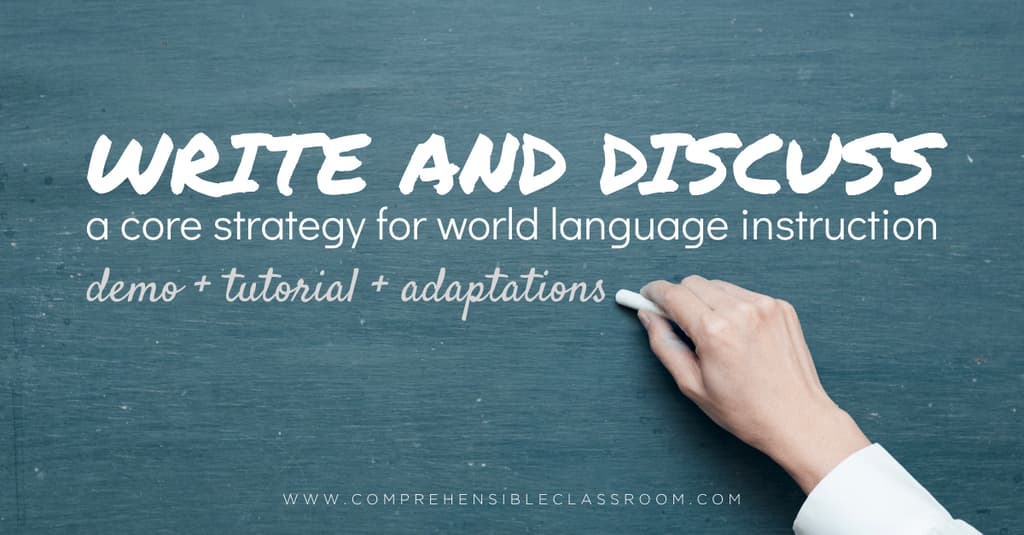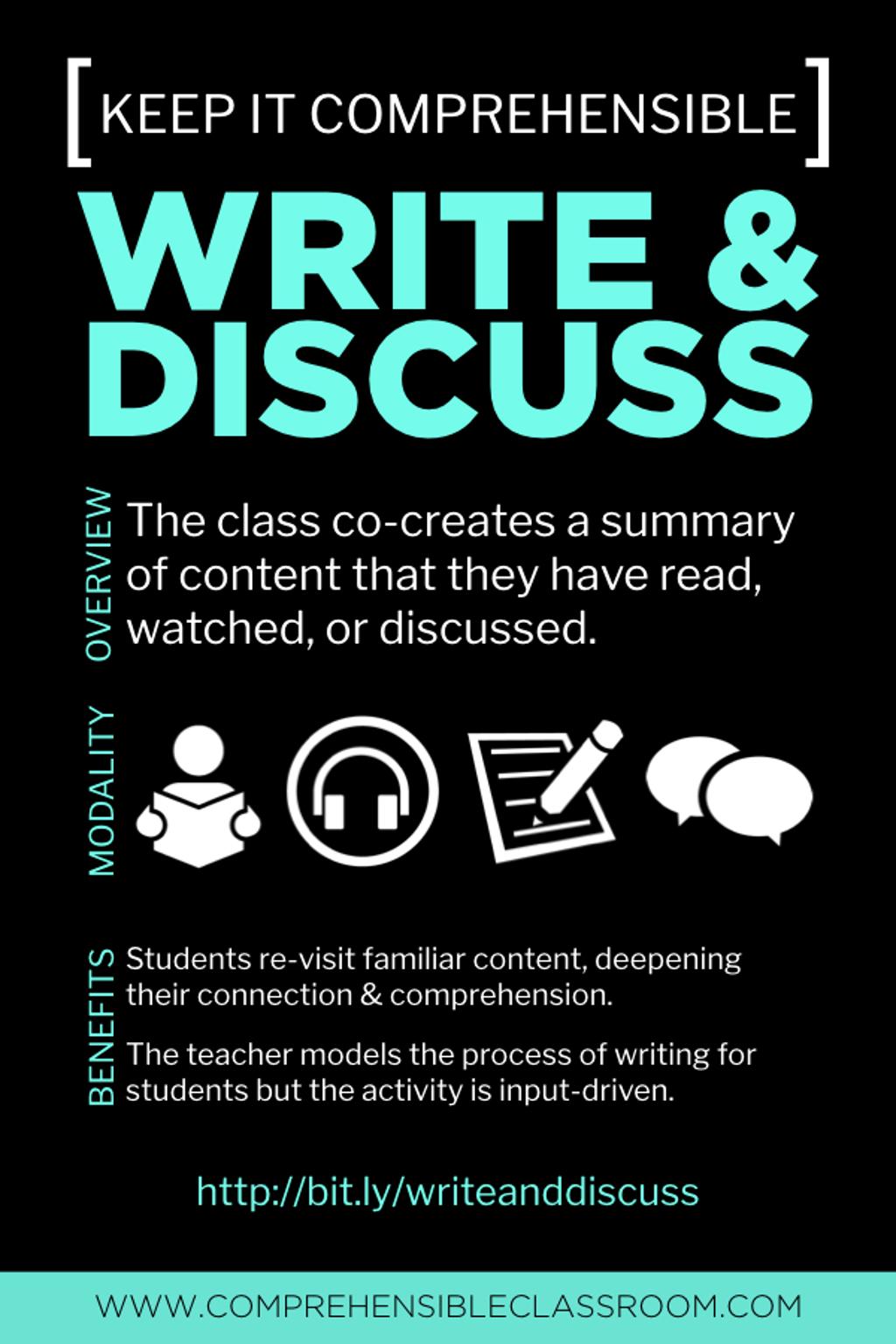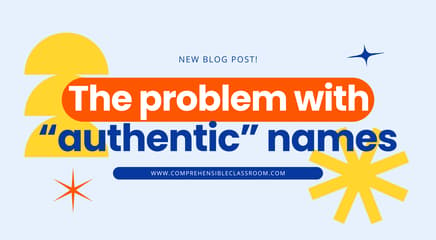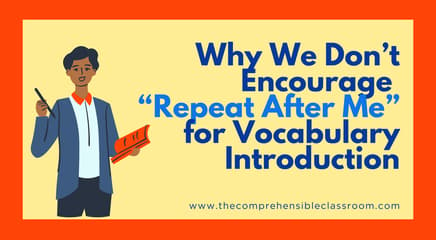"Write and Discuss" is one of the core strategies in a comprehension-based teacher's bag of tricks. It is easy-peasy and adaptable for many uses!
In this post, I'm sharing with you a demo of Write and Discuss along with step-by-step instructions so that you can feel confident making this power-packed strategy your own!

An abbreviated version of this post appeared in my newsletter last week--subscribe now!
WRITE AND DISCUSS DEMO: PRESCHOOL, ENGLISH
WHAT WE DID FIRST
The first step in Write and Discuss is sharing content. In this demo, one of my kids read a book to the rest of us. Sharing content could also look like:
- listening to a song or a podcast
- reading a book or a chapter from a book
- having a conversation or a discussion...or a debate!
- listening to a story (possibly told by the teacher or a classmate)
- watching a video
- reading an article
- examining a picture, object, or scene
- playing a game or participating in a shared activity
Basically, sharing content means giving everyone a shared experience or body of knowledge from which we can draw for the rest of the activity.
WHAT WE DID NEXT
Once we have shared content, we recall it together. The teacher guides this part of the conversation, often asking leading questions. Here are some common open-ended questions to ask about a story:
- Who was this about?
- What were they like?
- Where were they?
- What were they doing?
- What problem did they have?
- What did they do first/next/last?
Once you have answers to basic questions, you can begin asking for more details.
As you get information from the class, write it on the board or type it into a slide that is projected for the class to see.
DON'T JUST WRITE; DISCUSS!
Students will try to regurgitate the story as quickly as they can. It is your job to slow them down! Milk the text for more input.
Ask clarifying questions ("Is Cake an animal or is Cake a person?"). Write the wrong thing and wait for students to correct you ("This book is about a DRAGON (noooo!! a monkey!) and a Cake"). Ask personalized questions ("What do YOU like to do?"). Incorporate movement ("Stand up if ___!").

WRITE AND DISCUSS PLAN 2: SPANISH, ADULTS
Well, I was intending to post a second demo here for you buuuuuut turns out my camera ran out of memory while I was filming! Instead, I'll explain what I did with a very different kind of content in a very different instructional context!
SHARING CONTENT: CURRENT EVENTS
Because I am teaching two adults who are preparing for a trip to Perú, I have been trying to sprinkle information about Perú into our classes. Last Wednesday, I was planning to talk about Machu Picchu, but 30 minutes before I was supposed to leave the house for the lesson, I didn't have a sure plan. I popped onto TpT and searched for a reading about Machu Picchu that we could use as a jumping off point for conversation, and voilà! I found my own Machu Picchu article that I had forgotten about (I blame the babies). The article is a little...scandalous...so I knew that it would be perfect for my feisty learners!

This article, "Naked in Machu Picchu", is one of my "Fake News" articles. Each article in this series includes an adapted, accurate version of a true news story as well as a falsified version of the same story. The falsified version includes 5 factual errors. Students are encouraged to read the fake version, guess the errors, and then discover the truth by reading the real article.
WHAT WE DID FIRST: SHARE CONTENT
As I said before; the first step in Write and Discuss is sharing content. In this demo, this step was much more involved than in the Write and Discuss demo that I shared of me with my kiddos.
First, we read the fake version of the article. My students and I took turns reading segments of the article out loud while the rest of us followed along. I interrupted frequently to clarify meaning, to check for comprehension, and to personalize and customize the content. Learn more about reading together with your students here.
When we were done reading the fake version, we guessed which facts we thought were not true.
Next, we read together the TRUE news story. As we did, we identified each point of departure from the first article. Some of the inaccuracies were obvious and had been easy to identify (for example, Machu Picchu is in Perú, not Bolivia), but others were less obvious and opened up a good conversation. For example, in the fake article, the man who posed for the photos was quoted as saying that it was not a sacred site for him and that he did it for artistic reasons. In the real article, we learn that he posed for the photos with deep respect for Peruvians and for the site. This begged the question, "What matters more–your actions or your intentions?". Or perhaps, "Who gets to decide whether or not something is respectful– the doer or the receiver/observer?".
WHAT WE DID NEXT: WRITE AND DISCUSS WITH A TWIST!
This time, we did not just summarize the article for our Write and Discuss. Instead, we did a kind of Horizontal Conjugation. I told Leslie and Sabiha to imagine that they were in Machu Picchu that day and to re-tell the article from their perspective, as if they had seen what happened!
Here is what we came up with:

Here is what it says in English:
We decided to visit Machu Picchu in December 2014. It was a very interesting experience and different than our expectations. We saw a man. He was naked. He was running through the ruins. Initially, we thought, "How odd! but How handsome!". Then, we thought, "Why not?" It was very hot. So, we took off our clothes. Now, you can see a video of us on YouTube.
As you can imagine, the story would have been a little different had I been teaching in a middle or high school.
Use perspective change for exposure to first person verb forms
I had originally chosen to do a Horizontal Conjugation/Perspective Change with this Write and Discuss because I had noticed that my students are very comfortable using the second and third person verb forms because that is what they hear most often from me, and they often use those forms when they are talking about themselves. By asking them to retell the story from their own perspective, we focused the input on first person forms.
Perspective change...what I didn't expect!
Believe it or not, I did NOT coach L&S to create their own ending to the story! You know what? Humans are naturally creative, and we love imagining and laughing. When I tasked my friends to retell the story from their perspective, they of course injected their own personality and humor into it, and they played off each other! Instead of a straight perspective change, we ended up with a new, fun story and an emotional connection to the content. We remember what we feel, and so I was thrilled that this re-tell took this fanciful twist!
WRITE AND DISCUSS AND....READ!
Once you have written the summary to your satisfaction (or to your students' satisfaction), read it together! I did not demonstrate this in the video, but it is a key component of Write and Discuss.
SAVE IT FOR LATER
Snap a picture of your text so that you can project it for the class in the future or type it up to save more permanently.
NOW YOU TRY!
Think through the content that you have planned for this week. Will you be doing Weekend Chat? Reading a news article? Co-creating a story? MovieTalking? Playing Mafia?
Make a plan to follow up one of these activities with a Write and Discuss–and let me know how it goes!




